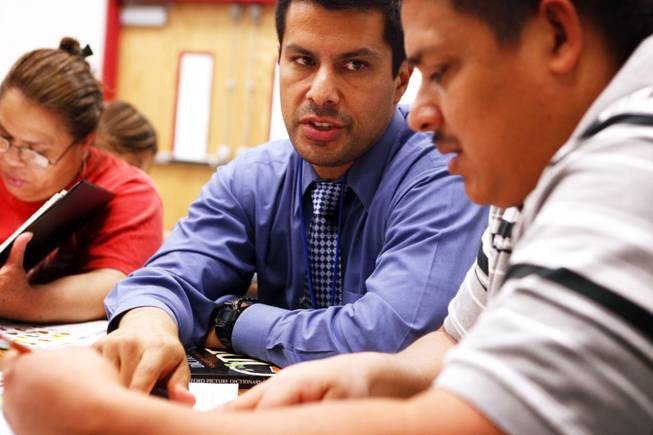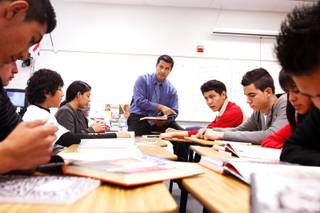
Western High School English teacher Edgar Acosta helps Jose Antonio Miranda during class for English-as-a-second-language parents taught after school at Western High School on Tuesday, Nov. 15, 2011.
Friday, Dec. 9, 2011 | 2 a.m.
Related story
Sun Archives
This is another in a yearlong series of stories tracking Clark County School District’s efforts to turn around five failing schools.
Edgar Acosta faces a daunting task as a teacher charged with improving reading test scores among some of the most challenging students in Clark County. They’re the ones who don’t speak English at home.
For the past two years, the remedial English teacher has worked day and night with immigrant children and their parents from mainly Latin American countries, helping them master a new language and adapt to a different country.
It’s a Sisyphean endeavor for Acosta’s Western High School, a turnaround school with one of the largest populations in the valley of students who are Hispanic and categorized as “English Language Learners.”
The once homogeneous high school experienced a dramatic demographic shift as the nation’s foreign-born population tripled in the past three decades. Earlier this year, Hispanics became the largest student group in Nevada, creating a greater sense of urgency for English teachers like Acosta.
Nevada’s low education statistics are sobering, he says, but even grimmer for its Hispanic students, less than a third of whom graduated in 2008, according to Education Week. At Western, the need to reach out to Latinos — who represent 65 percent of the entire student body — has become a necessity, he says.
“It’s very easy for this population to fall through the cracks,” Acosta says. “We want to make sure they have the opportunity to do what they intended to do when they came here.”
•••
As a turnaround school, Western received nearly a million dollars in federal stimulus funding this year to implement a bevy of changes — from starting a new math and science academy to replacing half of its staff.
The catch? Western must improve its graduation rate and test scores, which are among the lowest in the county. The key to turning around Western’s test scores is helping students who are learning English. They account for nearly a quarter of the student body.
They are usually foreign-born students who take English as a Second Language classes. They are the fastest growing segment of the student population and comprise about 10 percent of the nation’s K-12 enrollment, according to the National Council of Teachers of English.
Although there is a tendency to lump together all English-learning students, they bring different cultures and varying degrees of educational attainment to Western.
This diversity presents a unique challenge for teachers. Some students adapt more easily to a new language and culture, while others find it more difficult, whether it’s because of socioeconomic factors or cultural differences.
“Some students come here with very little schooling,” Acosta says. “Some kids are raised on a farm and it takes a lot longer to get them up to speed. That’s a big problem.”
Complicating matters is funding for English-language teachers like Acosta. Amid the economic recession, the School District cut those jobs back, raising class sizes.
“We’re cutting those positions at precisely the moment in time there’s a spike in that student population,” Gary Peck, executive director of the Nevada State Education Association, said at an education town hall last month. “I’m deeply troubled by all of that because of the implications it has on our state and our ability to compete in the global economy.”
•••
Regardless of the highly politicized debate surrounding immigration and despite the budget cuts to English-language instruction, Acosta is focused on one goal: Get his students to graduate and become productive members in a city decimated by the worst recession since the Great Depression.
“I don’t care what country you’re from,” he says of his students. “As a teacher, my goal is to get kids to do better in school.”
For Acosta, this challenge is all too familiar. The 14-year veteran teacher was born in California to Mexican immigrants who knew little English. In the 1970s — when Acosta was growing up — there were no programs to help English-deficient students catch up, he said.
“I was basically thrown to the wolves,” he said. “I learned English through osmosis.”
When he was a teenager, Acosta spent a summer helping his construction manager father build parking garages in San Francisco.
“After mixing cement all summer, I knew I didn’t want to be in construction,” he said. “I told myself, ‘I’ll go to college.’ ”
He graduated from Pepperdine University near Los Angeles and now hopes to instill the same drive in his students. He fears what will happen to them if they drop out, or fail to learn English by the time they graduate.
“Reading is an important skill,” he says. “If you don’t know how to read, it knocks you out of a lot of jobs.”
•••
On a recent morning, Acosta walks around a small group of students perched on desks pushed together in the middle of his classroom. He peers over students’ shoulders at the textbook they are reading aloud from.
“Maribel, traduce por favor,” Acosta tells a student. “Strange. Como es en Español?”
The girl mumbles its definition.
“Right,” says Acosta, who seamlessly shifts from speaking in English to Spanish and back again. “Something is strange when it’s different from what you’re used to.”
Try, try, try, he tells a Cuban boy with a heavy Spanish accent who is struggling to pronounce the word, “island” while reading another passage. “It’s eye-land, not is-land,” he says. “El ‘s’ es silencio.”
A girl on a nearby computer is stumped on a question, and the software won’t let her go on. Acosta rushes over to give her a hint. He notices a student on another computer who is wearing his hood in violation of the dress code. “Take your hood off,” he tells him.
A few minutes later, a boy walks into the class late with a note. Again, Acosta’s lesson is paused.
“It’s hard to give everyone individual attention,” he says with a sigh. “But this is better than nothing.”
One year, that’s all these students get in Acosta’s class. Afterward, they are shuffled off to regular and remedial classes, mixed in with native English speakers where it may be easier to fall behind without specialized instruction and engagement.
Time is ticking.



Join the Discussion:
Check this out for a full explanation of our conversion to the LiveFyre commenting system and instructions on how to sign up for an account.
Full comments policy